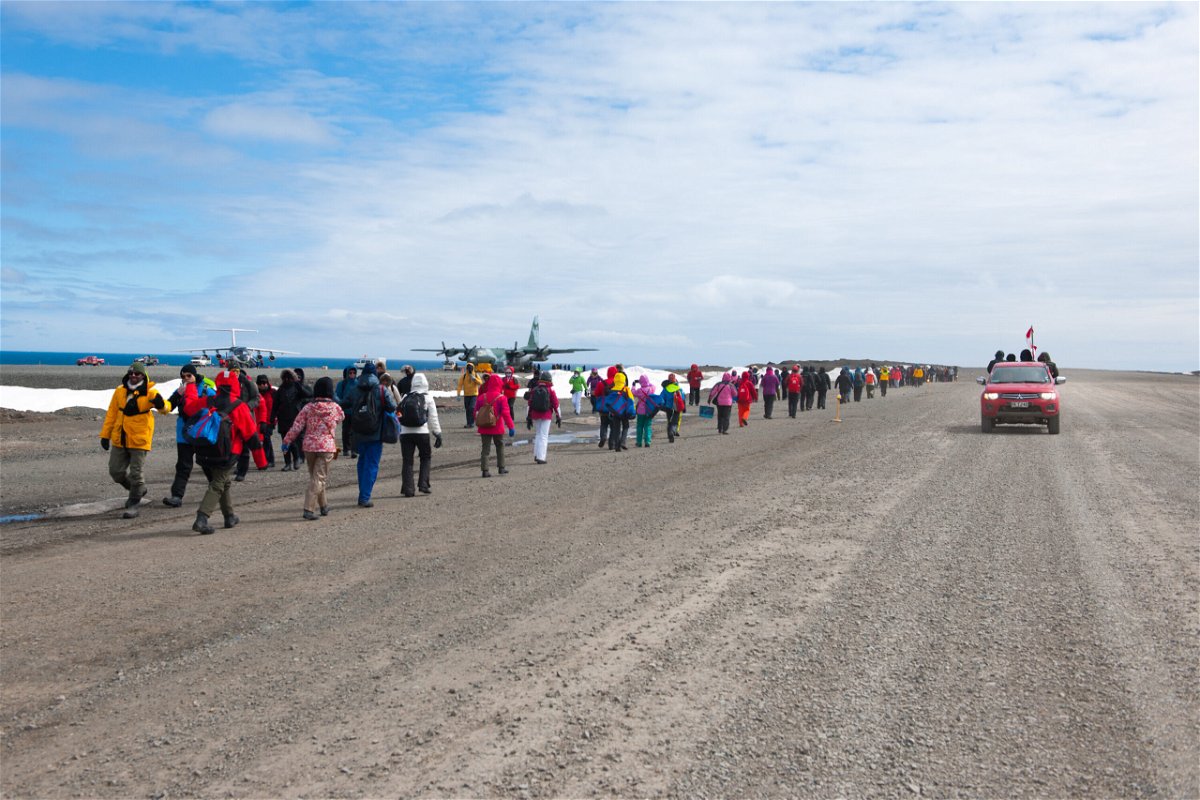What is black carbon? The latest way humans are causing changes in Antarctica

Tourists arrive for expeditions in Antarctica in December 2019 on King George Island. Scientists found the black carbon pollution from tourism and research activity has led to more melting on the frozen continent.
By Danya Gainor and Angela Fritz, CNN
There are few places on Earth that humans haven’t mucked up with the waste and pollution that comes from our gas-guzzling cars, the coal-fired electricity we power our homes with and the dust and soot that falls from the wildfires we’ve made worse.
Now even Antarctica — the only continent with no permanent human inhabitants — is being altered by the grit that follows us wherever we go.
A study published Tuesday in the journal Nature Communications found that the increasing human presence in Antarctica is causing more snow melt — bad news for a frozen world already battling the effects of human-caused global warming.
Black carbon — the dark, dusty pollution that comes from burning fossil fuels — has settled in locations where tourists and researchers spend a lot of time, scientists found. Even the smallest amounts of the dark pollutant can have a significant impact on melting because of its very low “albedo,” or reflectiveness: things that are light in color, like snow, reflect the sun’s energy and stay cool; things that are dark, like black carbon, absorb the sun’s energy and warm up.
Take bright, white snow and sprinkle some black pollution on it, and it’s a recipe for melting.
And what happens in Antarctica has global repercussions. It’s a massive, white continent that reflects a significant amount of the sun’s energy back to space. Losing ice and snow cover means land and ocean temperatures warm further, and that again causes more melting, in what becomes a vicious cycle of climate change.
“(Antarctica) is currently one of the most rapidly warming regions on the planet,” said Alia Khan, a snow and ice scientist at Western Washington University. “Snow is already melting due to impacts of climate change, but this is an exacerbating factor on snow melt.”
The researchers sampled snow around tourist sites and research-heavy locations from 2016 to 2020 and found the black carbon found in those samples was considerably more abundant than levels measured elsewhere on the continent.
The research found the highest levels of soot were measured near the Argentine research station in Hope Bay on the Trinity Peninsula, near the northern most part of Antarctica.
“(Tourist) ships in Antarctica generally use less-polluting marine diesel, and some vessels are supplementing fuel with battery power,” the study said. But the researchers note that their results show there’s more to be done to reduce pollution as tourism continues to increase.
Roughly 74,000 tourists visited Antarctica during the summer of 2019-2020, the researchers reported, a 32% increase from 2018-2019 and more than twice as many as a decade ago.
Khan said this study was important not just to understand what’s happening in Antarctica, but because global climate models — which scientists use to predict environmental changes decades and centuries in advance — need a better grasp on the impact of snow albedo on the climate system.
“The snow albedo effect is one of the largest uncertainties in regional and global climate modeling right now,” Khan told CNN. “That’s one of the motivations for the study, to quantify the impact of black carbon in Antarctica due to local emissions from research and tourist activities on regional snowmelt, which is important for quantifying the role of black carbon in the global loss of snow and ice.”
Marilyn Raphael, a geography professor and director of UCLA’s Institute of the Environment and Sustainability, explained that messing with the Antarctic could throw our planet’s delicate balance out of whack.
“[Antarctica] is sitting there pretty much silently all year. But, if it weren’t there, in the state that it is meant to be, the balance that we have in the climate system — the balance that we enjoy in the Northern Hemisphere — will no longer be,” Raphael said.
Tuesday’s study comes alongside an alarming record in Antarctica: the area of ocean covered by sea ice around the continent will hit a new low this year. Raphael said changes in sea ice, too, could have a global reach.
Antarctica’s sea ice is also important to maintain a balance in atmospheric circulation, Raphael said. This circulation drives the winds and is the means by which energy is transported into or out of the continent.
“If the atmospheric circulation changes, the global climate changes,” she said.
As waters get warmer and sea ice depletes, some Antarctic creatures are finding their homes more and more unlivable. Penguin colonies in Antarctica, for example, rely heavily on krill in their diets, and the krill rely on sea ice. Scientists have seen a shocking decline in penguin colonies recently, as krill becomes harder to find.
“Everything we do has consequences,” Raphael said. “We need to educate ourselves about those consequences, especially in systems that we know relatively little about. We have to be careful that we don’t upset the climate balance.”
This story has been updated with additional information.
The-CNN-Wire
™ & © 2022 Cable News Network, Inc., a WarnerMedia Company. All rights reserved.